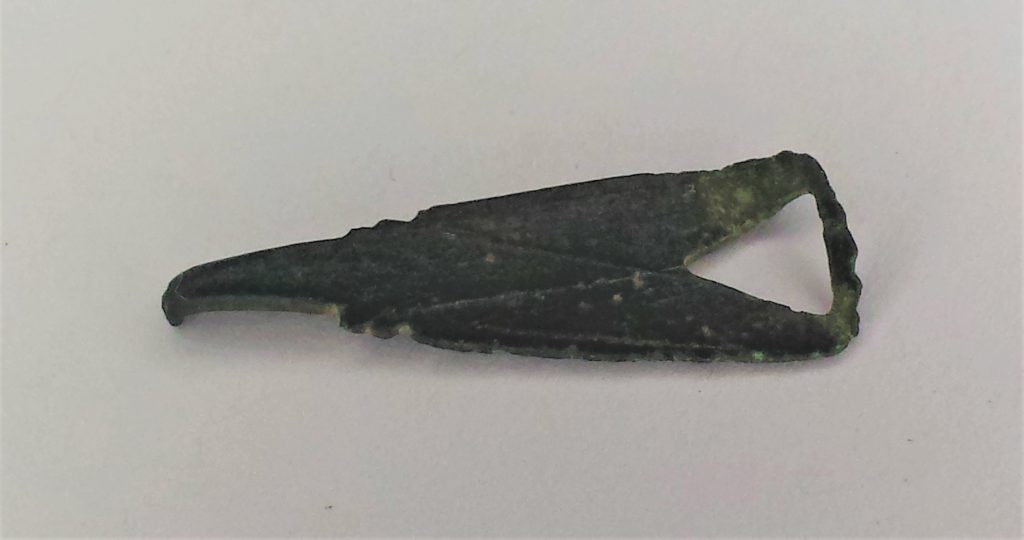I went to a SCA garage sale and picked up some garb and a few other things. One of which was this artifact. ( The Society for Creative Anachronism, Inc. SCA.org) The SCA is the historical hobby I do.
This was sold as an Early medieval bronze clothing fastener with simple linear decoration. 12th – 13th Century CE. Found in Suffolk England. My friend picked it up a long time ago. As it is a clothing accessory, or even a jewelry item, I thought it was perfect for my blog. So lets deconstruct this:

12th – 13th Century CE. Found in Suffolk England.
It is reasonable to assume this was a metal detecting find.
At first glance it looks remarkably like a skirt hook, but the size of it makes me doubt that. Most likely half of a clasp set for a pouch or a neckline. It could be the hanging end of a small chatelaine. it could possibly be for winningas as well. The broken part curves under towards the body implying to me that it was a small loop or most likely a small hook again leading me to believe this is half of a clasp of some sort or for winningas.
Upon closer examination, I agree this is probably bronze. in my handling it to take measurements, my fingers polished the edge of the broken hook at the end and the color is visually consistent with bronze.

it has an overall height of 26.80mmWidth: 8.68mm to 1.74mm at the end where the break occurred. I suspect the missing part would have been about the same width.The average thickness is 0.83mm. (About 20 gauge for those in the USA)
The hook itself would have been made from bending the metal over. so it would not be able to take a huge amount of force to cause it to bend. The broken end of the metal shows a grain structure consistent with work hardening so that is probably the reason this was discarded.
I do not think this was cast. This was forged out or made from sheet. it was decorated with a punch or chisel after it was cut out. The triangular eye was cut with a chisel (there is one mark that looks like it was cut slightly out of where it should have been.) The eye was then filed. You can still see the file marks and the smoothness of the lines (excepting that one spot mentioned above) is clear.
The decoration was put on with a sharp chisel. You can see at one spot where the chisel jumped when struck and there is a spot where you can see the double impression. There are also 2 distinct stamped decorations about 1.8mm in length. A line with a triangular point on each end. There are several spots where this might have been stamped, but due to corrosion and wear, it is not possible to be sure of any more than the 2 clearly defined stamps.
I will be duplicating this as a clasp set and as a set of winningas hooks later this year from a 2.00mm bronze sheet. The extra thickness should give me a lot more strength.
Edit: After posting this on a couple of groups on Facebook, I have had several people tell me that they think it is a clasp for winningas.
Winningas or winingas are long strips of cloth which were wrapped around the lower legs of Norman and Saxon men. They would have protected the bottom of the trouser legs from wear, preventing tears from brambles etc. With clothing being of considerable value and costly to replace or even repair, the importance of this cannot be overstated. Also by effectively closing off the shoe, they keep mud, stones and snow out, keeping one’s feet and legs drier, in winter conditions, than might otherwise be the case.
The above information is from the webpage https://wiki.vikingsonline.org.uk/Winningas
This Old English word winingas is the plural of wining (a word which relates to the act of ‘winding’). The equivalent term in Old Norse is Vindingr.
Winningas should be made from a fairly loose-weave herringbone twill wool fabric and be between 2 – 3 inches (5 -7.5 cm.) wide and around 12 feet (3.75m.) long. The wining is wrapped around the lower leg in a spiral, starting at the ankle (or around the foot) and ending just below the knee. Either tuck the ends into the bandaging or use pins or clasps to secure them.
If you have any other ideas, please make sure that you comment below. Thanks!
